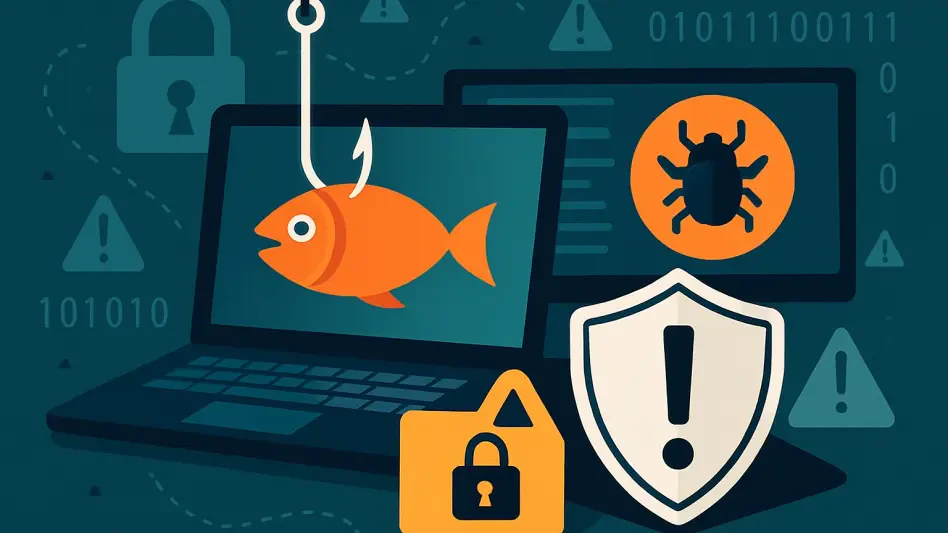In an era where digital connectivity underpins nearly every aspect of daily life, the alarming rise in cybersecurity threats has become a pressing concern for individuals, businesses, and governments worldwide, with recent reports from late September revealing a disturbing wave of sophisticated attacks. These range from phishing scams that prey on trust to malware that silently infiltrates high-value targets, alongside significant efforts by law enforcement to dismantle criminal operations. These incidents expose the fragile balance between technological advancement and security, as cybercriminals exploit vulnerabilities with ruthless precision. The stakes are higher than ever, particularly for cryptocurrency users, developers, and critical infrastructure, which have emerged as prime targets in this escalating digital battleground. As threats grow in complexity and scale, the urgency to understand and counter them has never been more critical, prompting a closer look at the evolving landscape of cybercrime and the responses shaping its future.
Emerging Cyber Threats
Phishing: Deceptive Tactics on the Rise
Phishing attacks have evolved into a formidable weapon in the arsenal of cybercriminals, leveraging human psychology with chilling accuracy to deceive even the most cautious users. A notable example involves a recent campaign targeting GitHub users with fake invitations to a prestigious accelerator program, mimicking legitimate communications from Y Combinator. These fraudulent messages, delivered through GitHub’s notification system, directed unsuspecting victims to spoofed domains designed to drain cryptocurrency wallets using malicious JavaScript. The level of detail in these scams, including subtle typos in URLs to evade detection, highlights how attackers exploit trust in familiar platforms. This incident, among others, underscores a broader trend of social engineering tactics becoming increasingly polished, posing a significant challenge to platform security and user vigilance in an environment where a single click can lead to devastating financial loss.
Beyond specific campaigns, the surge in phishing reflects a global challenge where attackers continuously adapt to bypass traditional defenses. These scams are no longer limited to poorly crafted emails but now infiltrate trusted ecosystems, blending seamlessly with legitimate correspondence. The implications are vast, affecting not just individual users but also entire communities within tech and cryptocurrency spaces, where the promise of opportunity often overshadows caution. Reports indicate that such attacks have spiked in frequency, with cybercriminals capitalizing on the rush of digital interactions to cast wider nets. The sophistication of these lures points to a critical need for enhanced user education on recognizing red flags, alongside stronger platform mechanisms to detect and block notification abuse before it reaches potential victims. As these deceptive tactics proliferate, the line between genuine and malicious grows ever thinner, demanding a reevaluation of how trust is established in digital communications.
Malware: Silent and Deadly Infiltrations
Malware continues to pose a severe threat, particularly with its ability to infiltrate systems undetected, targeting high-value groups like cryptocurrency users and developers with surgical precision. A striking case involves two malicious packages disguised as the legitimate “fast_log” in Rust’s Crates.io repository, which were downloaded thousands of times before detection. These packages were engineered to scan for cryptocurrency keys and sensitive data, transmitting stolen information to encoded URLs. Such supply chain attacks reveal a growing vulnerability in trusted ecosystems, where developers often assume safety in official repositories. The swift removal of these packages by Crates.io administrators demonstrates responsiveness, yet it also exposes the gaps in preemptive detection, emphasizing the urgent need for stricter vetting processes and real-time monitoring to safeguard against these silent infiltrations.
Equally concerning is the emergence of malware variants targeting specific environments, such as the XCSSET strain identified by Microsoft Threat Intelligence, aimed at macOS developers through infected Xcode projects. This malware not only steals cryptocurrency by swapping wallet addresses via clipboard hijacking but also extracts browser data, spreading through shared project files to maximize impact. This targeted approach illustrates how attackers exploit the very tools developers rely on, turning collaborative spaces into vectors for compromise. The incident highlights a disturbing trend of malware adapting to niche, high-value targets, where the potential for significant financial gain drives innovation in attack methods. Protecting these environments requires robust endpoint security and heightened awareness among developers to scrutinize shared resources, as the consequences of such breaches extend far beyond individual losses to threaten entire development communities.
Global Impact of Cybercrime
Infrastructure Under Siege
The scope of cybercrime extends far beyond personal devices, striking at the heart of critical infrastructure with potentially catastrophic consequences. A recent operation by the US Secret Service uncovered the largest SIM farm in the nation’s history, located near the United Nations headquarters, equipped with over 300 SIM servers and 100,000 SIM cards. This setup had the capacity to disrupt national telecommunications through mass spam and other malicious activities, posing a direct threat to security and stability. The discovery, prompted by threatening calls to senior officials, also revealed connections to broader criminal enterprises, including firearms and drugs, illustrating how cyber threats often intersect with physical crime. This incident serves as a stark reminder that digital attacks can have tangible, real-world impacts, necessitating a multi-layered approach to safeguard essential systems from such hybrid dangers.
Equally alarming is the vulnerability of other vital sectors, as evidenced by a ransomware attack on European airports through Collins Aerospace’s MUSE software, causing widespread flight delays at major hubs like London Heathrow and Berlin Brandenburg. The arrest of a suspect in the UK by the National Crime Agency marks a step forward, yet the disruption underscores how interconnected systems can become points of failure when targeted. These attacks on infrastructure reveal a pattern where cybercriminals exploit dependencies in global networks, amplifying the ripple effects of a single breach. The consequences are not just operational but also economic and societal, disrupting travel and commerce on a massive scale. Addressing these threats demands not only rapid response mechanisms but also proactive hardening of critical systems against ransomware and other exploits, ensuring that the backbone of modern society remains resilient in the face of relentless digital assaults.
Cross-Border Challenges
Cybercrime’s borderless nature presents a formidable obstacle, as threats originating in one region can swiftly impact others, creating a complex web of challenges for global security. Incidents like the ransomware disruptions at European airports and the SIM farm operation near a key international site in the US demonstrate how attacks transcend geographical boundaries, affecting diverse sectors from aviation to telecommunications. These events are compounded by the targeting of international cryptocurrency networks, where digital assets become tools for illicit gain across jurisdictions. The global scale of these threats means that no single entity can combat them in isolation, highlighting the critical need for coordinated strategies that bridge national and regional divides to track and neutralize criminal activities wherever they emerge.
Moreover, the interconnectedness of digital ecosystems amplifies the stakes, as a breach in one part of the world can cascade into widespread disruption elsewhere. The anonymity and speed of cyber operations allow perpetrators to operate from remote locations, often evading local enforcement until significant damage is done. This reality is evident in the vast networks of crypto wallets and bank accounts linked to crime, spanning dozens of countries, which require international collaboration to dismantle. Efforts like Interpol’s operations show promise, but they also reveal the sheer scale of resources needed to keep pace with globally organized criminal networks. Strengthening cross-border partnerships, sharing intelligence, and harmonizing legal frameworks are essential steps to mitigate these challenges, ensuring that responses match the fluid, transnational nature of modern cyber threats and protect vulnerable systems on a worldwide stage.
Fighting Back: Law Enforcement and Beyond
Major Takedowns and International Efforts
In the face of mounting cyber threats, law enforcement agencies worldwide have stepped up with significant operations that offer a glimmer of hope amid the chaos. A landmark achievement by the US Secret Service involved dismantling a massive SIM farm near a critical international hub, neutralizing a setup capable of severe telecommunications disruptions. This operation not only halted potential national security risks but also uncovered ties to wider criminal activities, showcasing the depth of coordination required to tackle such hybrid threats. The success of this takedown reflects a growing recognition among agencies that cybercrime often intersects with physical crime, requiring integrated approaches that combine digital forensics with traditional investigative techniques to disrupt these multifaceted operations effectively.
On an even broader scale, Interpol’s HAECHI VI operation stands as a testament to the power of international collaboration, with efforts spanning 40 countries to seize $439 million in cash and cryptocurrency linked to cybercrimes. Targeting over 400 crypto wallets and more than 68,000 bank accounts, this initiative led to notable arrests and asset recoveries across multiple regions, from Portugal to Thailand. Such global efforts highlight the necessity of pooling resources and expertise to combat criminal networks that operate without regard for borders. The scale of assets recovered underscores the financial motivations driving cybercrime, particularly in the cryptocurrency space, where anonymity fuels illicit transactions. These victories, while significant, also serve as a call to maintain momentum, ensuring that international partnerships continue to evolve and adapt to the sophisticated tactics employed by cybercriminals in an ever-changing digital landscape.
The Need for Prevention
While major takedowns provide critical wins, they also expose the limitations of reactive measures in a landscape where cyber threats evolve at breakneck speed. Each incident, whether it’s ransomware crippling airport operations or supply chain attacks in trusted repositories like Crates.io, reveals how attackers often strike before defenses can adapt. Relying solely on after-the-fact responses risks perpetual catch-up, leaving systems vulnerable to the next wave of innovation in criminal tactics. This reality drives home the importance of prevention, where investments in robust security frameworks, such as advanced threat detection and stricter vetting processes for digital platforms, can stop breaches before they occur. Building resilience into systems from the ground up is no longer optional but a fundamental requirement to safeguard against the relentless ingenuity of cybercriminals.
Equally vital is the role of user education in fortifying the human element of cybersecurity, often the weakest link in the chain. Many successful attacks, particularly phishing scams, exploit a lack of awareness, tricking users into actions that compromise security. Comprehensive training programs that teach recognition of suspicious communications and safe digital practices can significantly reduce the success rate of social engineering schemes. Alongside this, platforms must enhance their own safeguards, implementing stronger authentication and real-time monitoring to catch malicious activity at its inception. Reflecting on past responses, it’s clear that a shift toward proactive strategies paid dividends in minimizing damage. Moving forward, blending prevention with rapid response, supported by global cooperation, offers the most viable path to outpace threats and secure the digital future against the backdrop of lessons learned.








